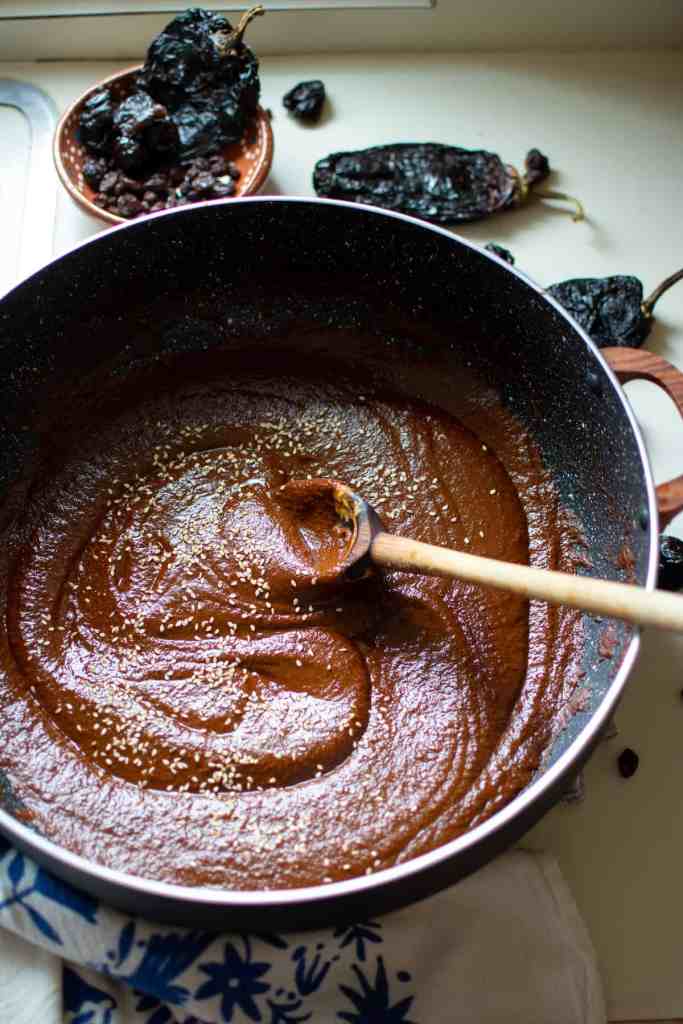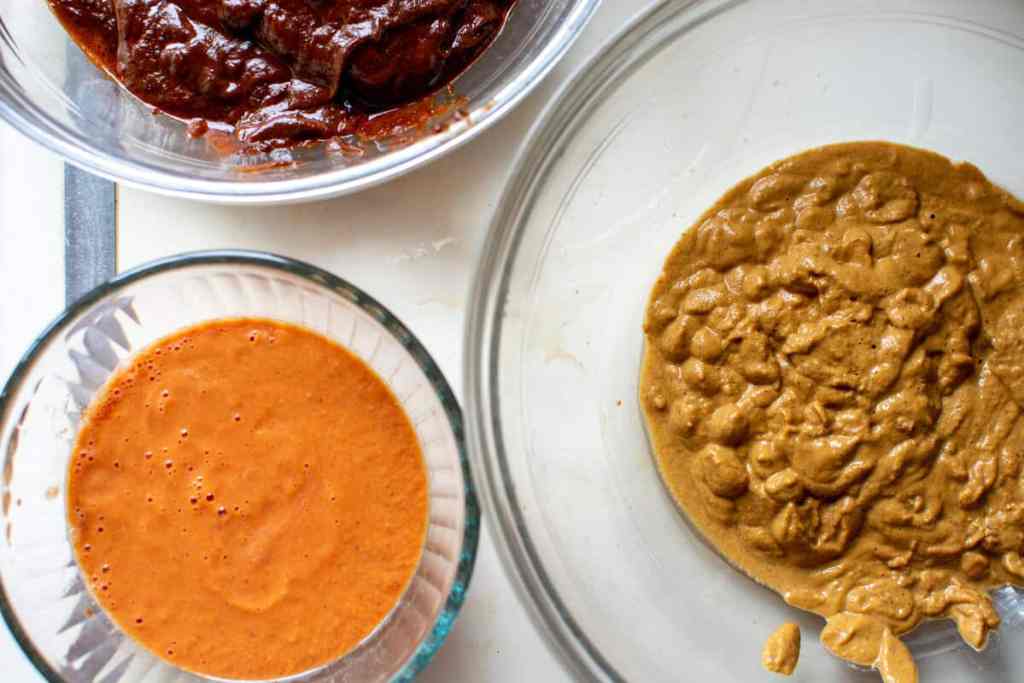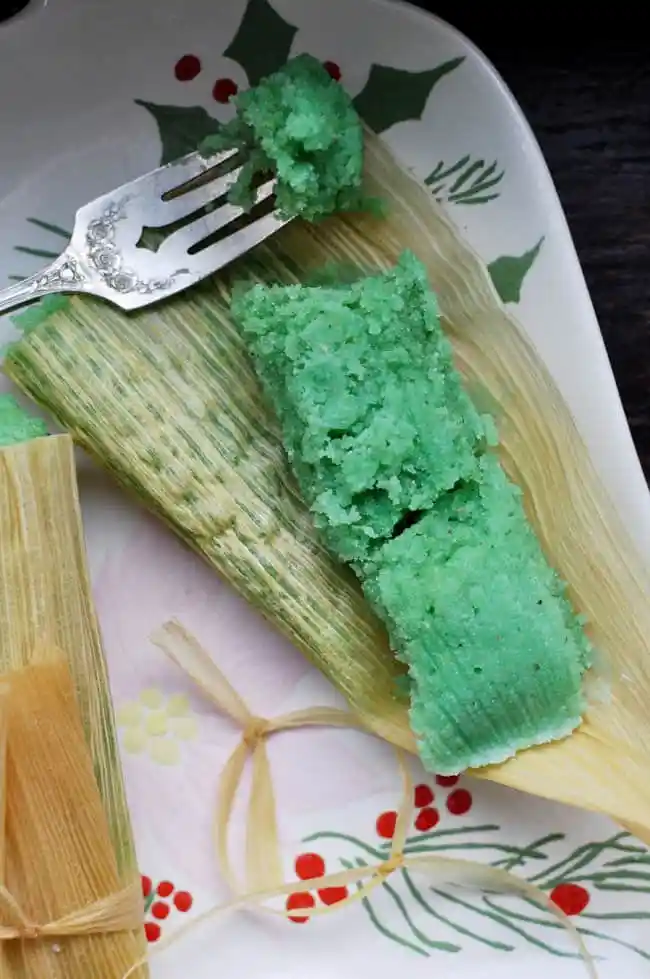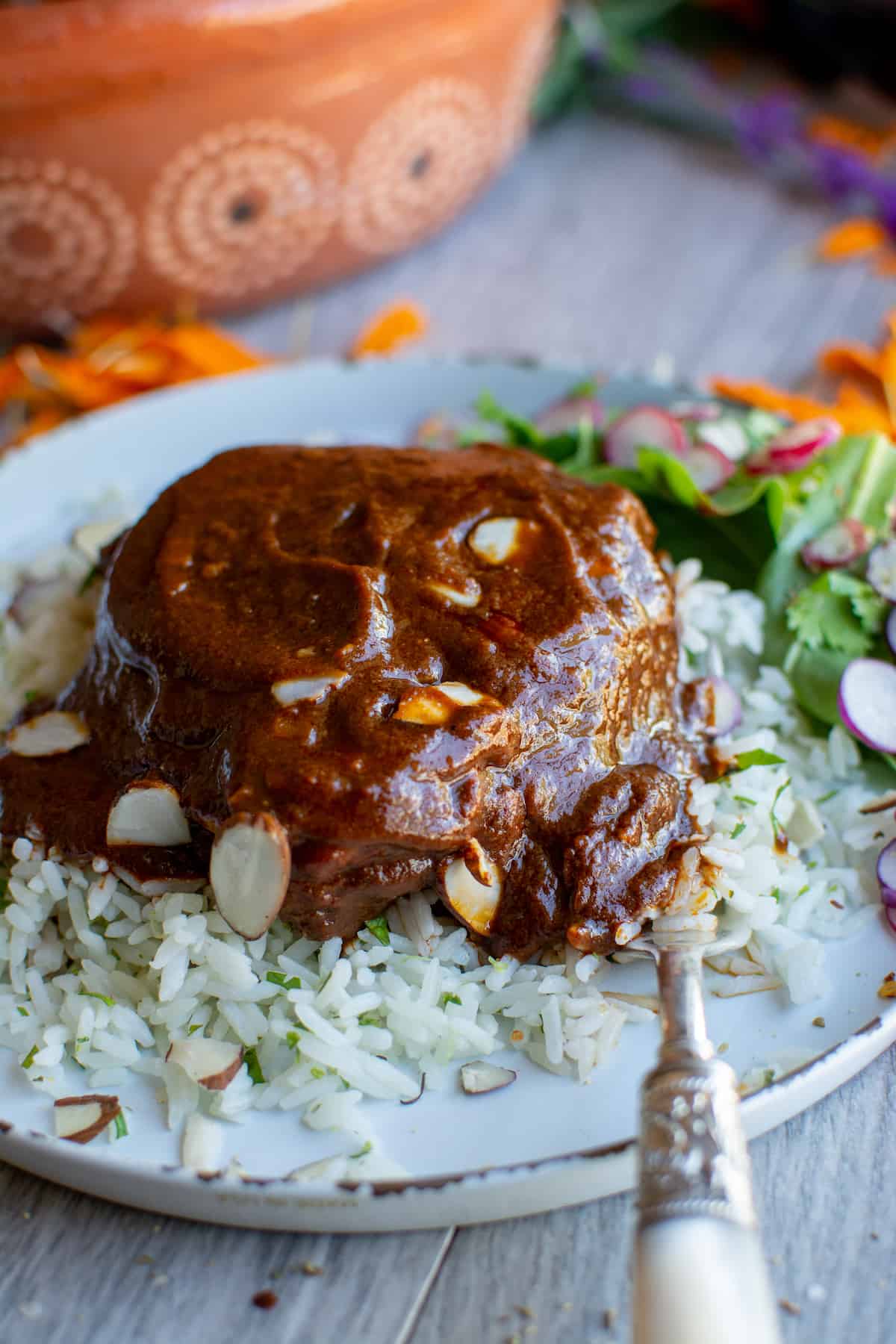Mole Poblano, Mexico’s most famous sauce and the pride of Puebla’s cuisine, is layered, complex, and mysteriously rich. This recipe takes you step-by-step on how to make it. Check out the video!

This past October I joined my friends at California Grown on a agritour through the Central San Joaquin Valley. If you’ve been reading this blog for a while, you’ll know that traveling through the farm fields of California is one of my favorite things to do.
I’ve been fortunate enough to have visited farmland in Santa Barbara, Monterey County, and even a virtual tour during the pandemic. On each trip I’ve had the opportunity to meet and chat with farmers and farmworkers about the devotion and hard work that goes into feeding the country. Did you know that two thirds of all fruits and vegetables sold in the United States is grown in California?!
Celebrating Farmer and Farmworker Month

The trip in October was particularly meaningful because October is Farm and Farmworker Month in California. Our trip was in celebration of their contributions and to get a real boots-on-the-ground look at what they do day in and day out.
We saw how kiwifruit is picked by hand at the height of flavor from overhead vines, the meticulous way figs are selected and packaged and even got to ride on a DOV (dried on the vine) raisin harvester as it collected the raisins from the vines then, in a delicate dance, shot them out into a waiting cart in the next row over.

The Central San Joaquin Valley is the most prolific growing area in the world, cultivating over 250 crops. We drove by fields of pistachios, wine grapes, olive trees, almonds, prunes, pumpkins, you name it, they probably grow it. I wanted to create a recipe that celebrates as many of these ingredients as possible. And what Mexican recipe has more ingredients than Mole Poblano?
This beautiful complicated sauce made with dried chile peppers, nuts, seeds and spices, dried fruit, and more is traditionally made as an important dish for special occasions and festivities so I could think of nothing more appropriate to honor gorgeous California produce and the people who grow it.
More To Explore
What Is Mole Poblano?

There are many types of mole sauces throughout Mexico but the one you will be served in Puebla, Mexico is Mole Poblano. It is a sensuous sauce full of complex flavors from the dried chiles, nuts, seeds, herbs, and chocolate added to it.
It is not spicy but deep and rich, each flavor blending seamlessly together so no one in particular stands out but all work in harmony to create a beautiful sauce that is spooned over poached chicken or simply enjoyed with a warm tortilla.
To make it is a time commitment. This recipe is neither fast, nor easy but rather, a labor of love. Each ingredient tenderly prepared in a way that brings out its natural essence, then combined in the final moments to make the finished sauce.
Ingredients To Make Mole Poblano

I have taken some liberties here to include ingredients we saw being grown in the Central San Joaquin Valley of California. More traditional substitutions are mentioned in the step-by-step section.
- Dried Ancho chiles (CA Grown)
- Dried Pasilla chiles (CA Grown)
- Dried chipotle chiles (CA Grown)
- Raisins (CA Grown)
- Prunes (CA Grown)
- White onion (CA Grown)
- Garlic cloves (CA Grown)
- Canela (Ceylon cinnamon)
- Anise seed
- Black peppercorns
- Sliced almonds (CA Grown)
- White sesame seeds
- Pistachios (CA Grown)
- Dried Mexican oregano (CA Grown)
- Kosher salt
- Ground coriander
- Avocado oil (CA Grown)
- Tomatoes (CA Grown)
- Mexican chocolate
- Corn tortilla
How To Make Mole Poblano (Step-by-Step Instructions)
step one
Clean and seed the chiles. Remove the stems and seeds from all the dried chiles and rinse to remove any dirt or extra seeds. To make this Mole Poblano recipe I used dried ancho, pasilla, and chipotle chiles but mulato chiles are also very common.

step two
Fry the chiles. Bring a large saucepan of water to a boil. Then heat 1/4 cup of avocado oil (or vegetable oil) in a large skillet over medium heat to fry the chiles. Once the oil is warm add the chiles (do this in batches if your pan is not big enough) and fry, turning in the oil until they have deepened in color and are fragrant. Transfer to the boiling water. Remove the pan from the heat, add the raisins and prunes and let soak in the hot water for at least 30 minutes.
*If you want a more classic tasting mole substitute lard for avocado oil in this recipe.

step three
Char the onions and garlic. Heat a comal or a dry frying pan over medium-high heat. Once it is hot, place the onion wedges and garlic cloves in the pan. Let char and blacken on all sides, turning frequently, about 15 minutes. Transfer to a bowl.

step four
Toast the spices. Reduce the heat to low and add 2-inch stick cinnamon (canela), anise seed, and peppercorns. Toast until fragrant, about 30 seconds to a minute. Remove to a spice grinder or a clean coffee grinder. Let cool, then grind to a fine powder.
*You can also use 1 teaspoon coriander seed here instead of the ground coriander. If using whole coriander seed, toast it with the other spices.

step five
Char the tomatoes. Increase the heat to medium. Place the tomatoes on the comal and cook until the skins are charred on all sides, about 10 minutes. Transfer to a separate bowl and let cool.

step six
Toast the nuts. Heat 1 tablespoon of avocado oil in a small frying pan over medium-high heat. Add the almonds and pistachios until golden and toasted, about 2 minutes. Remove to a bowl with a slotted spoon.
*It is traditional to use peanuts and/or pumpkin seeds but I wanted to highlight the California Grown ingredients. Substitute raw shelled peanuts for the pistachios, if you prefer.

step seven
Fry the sesame seeds. Add another tablespoon of avocado oil to the pan and add the sesame seeds. Stir frequently until golden, about 1 minute, then remove to a separate bowl and wipe out the frying pan with a paper towel.

step eight
Toast the tortilla. Heat one more tablespoon of avocado oil in the frying pan over medium-high heat. Once hot, add the tortilla and fry until toasted and crisp. Transfer to a plate.

step nine
Blend the chiles and dried fruit. Remove the chiles and dried fruit from the water with tongs and place in the blender. I did this in 3 batches because I have a small blender. Add 1/4 cup of the reserved chile water (or chicken broth) with each batch and blend on high until smooth. Save the leftover chile soaking liquid you will use it later.

step ten
Strain the chile mixture. Strain the mixture into a large bowl by pushing it through a fine mesh strainer. You don’t have to do this, but it makes for a very silky, luxurious sauce.

step eleven
Keep blending. Now add the onions, peeled garlic cloves, tortilla (break into a few pieces), toasted nuts, sesame seeds, ground spices, coriander, salt, and oregano to the blender. You don’t need to rinse it out first. Add 1/2 cup of the reserved chile water (or chicken stock) and blend until smooth.

step twelve
Keep straining. Strain this mixture through the cleaned sieve into a separate large bowl. Really scrape and push on the mixture to get all the puree out.

step thirteen
Blend the tomatoes. Finally, blend the tomatoes and strain into a separate bowl.

step fourteen
Cook the mole sauce. Heat 1/4 cup of the avocado oil in a large pot or Dutch oven over medium high heat. Once the oil is shimmering, stir in the chile mixture, be careful, it will sputter and spurt but keep stirring, frying it in the hot oil. Once that has cooked for a few minutes, add the nut mixture, stir that in then add the tomato mixture and the chocolate. Reduce the heat to low and let that simmer, stirring frequently, until the chocolate has melted and the sauce is smooth.
If it is too thick, add more of the reserved chile water (or chicken stock) 1/4 cup at a time until it coats the back of a spoon but is not gloppy or runny. Taste and add more salt as needed.

How To Serve It
- Serve instead of or in addition to Thanksgiving gravy to sauce your turkey and mashed potatoes.
- Spoon over cooked chicken and sprinkle with sesame seeds.
- Make enmoladas (like enchiladas but with mole sauce instead of enchilada sauce). You can find a recipe in my book, Plant Powered Mexican.
- Use to flavor a pot of beans.
- The sauce you need for your holiday tamales.
More Ways To Use California Grown Produce
Although many ingredients we saw growing and harvested are featured in this Mole Poblano there are so many ways to enjoy California’s top notch fruits, vegetables, and nuts. Let’s take a look at some more recipe ideas!
Raisins



Kiwifruit



Figs



Pumpkins



- Pumpkin Mole Sauce
- No-Bake Pumpkin Chipotle Cheesecake
- The Best Pumpkin Pie Recipes (from our sister site, Kate’s Best Recipes)
Look For California Grown Ingredients
When you are shopping for the Mole Poblano recipe and every time you go to the store! Let me know when you do by snapping a pic and tagging me on Instagram @holajalapeno and #holajalapeno so I can see or leave me a comment below (don’t forget to leave a ⭐️⭐️⭐️⭐️⭐️ rating) ! Also, sign up for my weekly newsletter, lots of good stuff there too!

Mole Poblano Sauce
Mole Poblano, Mexico’s most famous sauce and the pride of Puebla's cuisine, is layered, complex, and mysteriously rich. This recipe takes you step-by-step on how to make it. Check out the video!
Ingredients
- 9 dried pasilla chiles
- 8 dried ancho chiles
- 4 dried chipotle chiles
- 1/2 cup, plus 3 tablespoons avocado oil, divided
- 1/2 cup (about 3 ounces) raisins
- 1/2 cup (about 4 ounces) prunes
- 1 large white onion, quartered
- 8 unpeeled cloves of garlic
- 2 inch piece canela (Ceylon cinnamon sticks)
- 10 black peppercorns
- 1/2 teaspoon anise seeds
- 10 ounces tomatoes (about 3 large), cored
- 1/4 cup sliced almonds
- 1/4 cup shelled pistachios
- 1/2 cup white sesame seeds, divided
- 1 small stale corn tortilla
- 1 teaspoon dried Mexican oregano
- 2 teaspoons kosher salt
- 1/2 teaspoon ground coriander
- 1 1/2 ounces Mexican dark chocolate
Instructions
- Remove the stems and seeds from the dried chiles then rinse under running water to remove any dust or extra seeds.
- Bring a large saucepan of water to a boil. Heat 1/4 cup of the avocado oil in a large frying pan over medium heat. Once shimmering add the chiles and fry. You may need to do this in batches depending on the size of your pan. Fry the chiles in the oil, turning frequently until their color deepens and they become fragrant.
- Transfer the chiles to the boiling water. Add the raisins and the prunes and remove from heat. Soak the chiles until they have softened, at least 30 minutes.
- Heat a large comal or dry frying pan over high heat. Place onion wedges and unpeeled garlic cloves on the hot comal and cook until they are charred and skin is blackened on all sides, about 15 minutes. Transfer to a bowl and peel the garlic cloves once cool.
- Reduce heat under the comal to low. Add canela, peppercorns, and anise seed and toast until they are fragrant, about 30 seconds to a minute. Remove to a spice grinder or clean coffee grinder. Let cool and then grind into a fine powder.
- Raise the heat under the comal back to high. Add tomatoes and let cook until charred on all sides, about 10 minutes. Remove to a separate bowl.
- Heat 1 tablespoon of the avocado oil in a small frying pan over medium heat. Add the almonds and pistachios and fry stirring frequently until golden and toasted, about 2 minutes. Remove to a bowl.
- Add another tablespoon of oil to the skillet add sesame seeds. Toast for 1 minute, stirring constantly. Remove to a separate bowl and wipe the skillet clean with a paper towel.
- Heat one more tablespoon of oil in skillet and add the tortilla. Fry until crisp then remove to a plate. Let cool then break into a few large pieces.
- Remove chiles and dried fruit with tongs and place into a blender. I did this in 3 batches because my blender is small, you may be able to do yours in one batch if you have a larger blender like a Vitamix. Save the soaking liquid from the chiles and add 1/4 cup to the blender. Blend until very smooth then strain into a large bowl with a fine mesh sieve. You don't have to strain it, but you will get a much silkier, more luxurious sauce if you do. Really push and scrape the mixture through the sieve to get all the puree out, leaving only the chile skins and seeds behind
- Add the onions, garlic, ground spices, nuts, 1/3 cup of the sesame seeds, tortilla, coriander, salt, and oregano to the blender. Add 1/2 cup of the chile soaking liquid and blend on high until smooth. Strain into a separate large bowl like you did with the chiles.
- Puree the tomatoes in the blender, strain into a separate bowl and set aside.
- Heat 1/4 cup avocado oil in a large pot or Dutch oven over medium heat. Once shimmering add the chile puree—be careful it will spurt and sputter—stir constantly. Continue frying the puree in the oil until it has changed color and looks toasted, about 4-5 minutes.
- Add the nut puree and stir that into the chile puree, cooking it in the oil. Now stir in the tomatoes and add the chocolate. Stir constantly, simmering the sauce until the chocolate has melted and the sauce is smooth. Lower the heat if it begins to boil too rapidly.
- If the sauce is thick add more of the chile soaking liquid, 1/4 cup at a time, until it reaches a silky consistency. It should be thick enough to coat the back of a spoon and not gloppy. Taste and add more salt if needed.
- Serve over cooked turkey or chicken or use to fill tamales or make enmoladas. Garnish with remaining sesame seeds.
Notes
Chicken broth can be substituted for the chile soaking liquid but then the recipe would no longer be vegan.
Recommended Products
As an Amazon Associate and member of other affiliate programs, I earn from qualifying purchases.
In support of this small business, ¡Hola! Jalapeño earns revenue in a few different ways. Several sponsored posts are published each month, for example, this post is sponsored by California Grown. I also earn an affiliate commission on the sales of products I link to— there are a few of those links in this post. I only feature items I genuinely love and personally use on a regular basis. This commission is an arrangement between the retailer and ¡Hola! Jalapeño (readers never pay more for products). This income allows me to run the site. Thank you for reading!










leave a reply